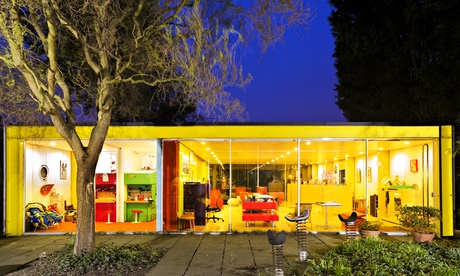
In about 1950, the architect Berthold Lubetkin had an arresting but rejected vision for Peterlee, the new town built for a mining community in County Durham. He wanted to run a main road through its centre, such that “young couples could sit on its banks watching the traffic, the economic pulse of the nation, with coal and pig iron in huge lorries moving south, while from the south would come loads of ice-cream and French letters”. His vision was not adopted, with the artist Victor Pasmore instead being invited to compose blocks of housing as units of mass and colour as if in a giant painting, with some help from inexperienced architects on the details. Pasmore’s involvement lasted until 1977, but his estates had their problems, partly due to skimping on insulation and roofing felt.
These are among the more striking manifestations of what Elain Harwood calls “a period of optimism and endeavour” of a kind that seems unlikely to return “for a long time”. She also says that its architecture “is as valuable as any in our heritage – the more so, indeed, because it was intended for all of us and to challenge rather than enforce the social status quo”. The main story, for her, is one of serious-minded young architects, many of them shaped by wartime experiences, determined to build a better future out of the rubble of the old, and to mobilise the resources and organisational power of the military in the interests of peacetime life.
Attacks on architects of this period like to portray them as omnipotent ideologues, marching in well-drilled cadres to the beat of Le Corbusier’s or Walter Gropius’s fanatical fantasies. They were “utopian” and “dogmatic”. The world Harwood describes is more messy and confused, full of disagreement and self-criticism, with the pursuit of high ideals forever dodging or foundering on such things as shortages of building materials and the stop-go nature of public finance.
Harwood talks about the best-known architects and projects – Denys Lasdun, Peter and Alison Smithson, Coventry Cathedral, Milton Keynes – but gives equal space to less-sung figures ensconced in local authority offices, such as SAG Cook in the London borough of Camden and Rosemary Stjernstedt, who left her mark on Stevenage, Roehampton and Crystal Palace. There are libraries closed or lost in Redcar and Newcastle and another, still open, in St Austell. There are bus stations, service stations, ventilation towers, a signal box, and some quite beautiful and little-known private houses.
With the help of handsome photographs by James O Davies, the 700-page book describes a wide range of styles, including skinny Scandinavian-influenced buildings soon after the war, and brutalism, whose robust celebration of the processes of construction – such as exposing the imprints on concrete left by its timber moulds – was called “glorying in the smell of the shop”. The timespan includes early versions of the hi-tech style of Richard Rogers and Norman Foster. Some sought inspiration in Laurie Lee’s description of Italian hill-towns, where “the shepherd on the hill was visible from the market square”, others in the radical Italian architects Superstudio, who imagined covering the world in a giant architectural grid.
There were those who simply carried on building country houses and law courts in variations of classical styles, the best being the practice of McMorran & Whitby. Harwood gives due credit to all of these, as she does to Tayler and Green, who quietly turned out 700 low-cost homes in a modified traditional style in the Norfolk district of Loddon. Her definition of architecture extends beyond individual buildings by named architects to include such things as the landscape design of Geoffrey Jellicoe, and the attempts to turn the production processes that had built Spitfires to making prefab houses.
Yet if these architects were mostly not the megalomaniacs of caricature, many of them liked to think big. They built homes by the thousand, new towns and, in Milton Keynes, what was billed as a “new city”. They applied the grandest precedents – Georgian Edinburgh, Royal Crescent in Bath – to modest housing, and Stevenage’s shopping centre was modelled on Venice’s Piazza San Marco. Some of it ended in tears, in corruption, leaky roofs and unhappy residents. There were the Point brothers, Ronan and Centre, one an East End tower block that partly collapsed, the other a West End speculation that remained scandalously empty in a time of housing crisis. But the overall achievement is extraordinary.
Harwood is an expert on this period of architecture at Historic England, formerly English Heritage, which is a co-publisher of the book. She is a key figure in the processes by which the best (hopefully) of these buildings get listed. This background enables her to bring an exceptional breadth and depth of knowledge to the subject, including of the political and economic pressures and of the various individuals behind the projects. It also means that Scotland is excluded and that the volume of information sometimes overwhelms the narrative. This is not a book to be read from beginning to end, in one go. But for anyone interested in the subject, it is a highly satisfying and comprehensive assembly of projects, images, facts and stories.
Space, Hope and Brutalism is published by Yale University Press (£50). Click here to buy it for £50

